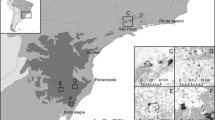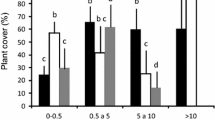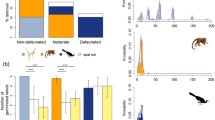Abstract
Animals aid population growth and fitness in tropical forest communities through dispersal and negatively impact populations through seed predation. The interaction between dispersal and seed predation can produce distance- or density-dependence; powerful mechanisms for maintaining species diversity incorporated in the Janzen–Connell model. Large mammals, the highest biomass seed predators of intact Amazonian communities and at risk due to human disturbance, are potentially central to these interactions. This study tests the Janzen–Connell model and investigates the impact of mammalian seed predators on seedling recruitment and maintenance of tree diversity. Patterns of both vertebrate and invertebrate seed predation and seedling recruitment were studied in the two most abundant canopy tree species in western Amazonia (Arecaceae: Astrocaryum murumuru and Iriartea deltoidea). We specifically examined effects of both spatial and temporal variation of the highest biomass seed predator in southwest Amazonian forests, the white-lipped peccary (Tayassu pecari), on recruitment through disturbed and undisturbed sites and through a fortuitous 12 year natural extinction and recolonization event of T. pecari. Distance-dependent seedling recruitment was found in Astrocaryum and Iriartea at both sites. However, the median distance of seedlings was ~1.5× farther from reproductive adults in both palms at the undisturbed site. The number of Iriartea seeds escaping predation increased 6,000% in both space and time due to the decline of T. pecari abundance. The results demonstrate that Janzen–Connell effects are stronger in intact ecosystems and tie these mechanistically to changes in seed predator abundance. This study shows that anthropogenic changes in mammal communities decrease the magnitude of Janzen–Connell effects in Amazonian forests and may result in decreases in tree diversity.





Similar content being viewed by others
References
Augspurger CK (1984) Seedling survival of tropical tree species: interactions of dispersal distance, light-gaps, and pathogens. Ecology 65:1705–1712
Barone JA (2000) Comparison of herbivores and herbivory in the canopy and understory for two tropical tree species. Biotropica 32:307–317
Barot S, Gignoux J, Menaut JC (1999) Seed shadows, survival and recruitment: how simple mechanisms lead to dynamics of population recruitment curves. Oikos 86:320–330
Blate GM, Peart DR, Leighton M (1998) Post-dispersal predation on isolated seeds: a comparative study of 40 tree species in a Southeast Asian rainforest. Oikos 82:522–538
Bodmer RE, Fang TG, Moya L, Gill R (1994) Managing wildlife to conserve Amazonian forests-population biology and economic-considerations of game hunting. Biol Conserv 67:29–35
Burkey TV (1994) Tropical tree species diversity: a test of the Janzen–Connell model. Oecologia 97:533–540
Clark DA, Clark DB (1984) Spacing dynamics of a tropical rain forest tree-evaluation of the Janzen–Connell model. Am Nat 124:769–788
Clark DA, Clark DB, Sandoval MR, Castro CMV (1995) Edaphic and human effects on landscape-scale distributions of tropical rain forest palms. Ecology 76:2581–2594
Condit R, Hubbell SP, Foster RB (1992) Recruitment near conspecific adults and the maintenance of tree and shrub diversity in a neotropical forest. Am Nat 140:261–286
Condit R, Pitman N, Leigh EG Jr, Chave J, Terborgh J, Foster RB, Nuñez P, Aguilar S, Valencia R, Villa G, Muller-Landau HC, Losos E, Hubbell SP (2002) Beta-diversity in tropical forest trees. Science 295:666–669
Connell JH (1971) On the role of natural enemies in preventing competitive exclusion in some marine animals and in rain forest trees. In: den Boer PJ, Gradwell GR (eds) Dynamics of populations. Proceedings of the advanced study institute on dynamics of numbers in populations, Oosterbeek, 1970. Centre for Agriculture Publishing and Documentation, Wageningen, pp 298–310
Connell JH, Tracey JG, Webb LJ (1984) Compensatory recruitment, growth, and mortality as factors maintaining rain-forest tree diversity. Ecol Monogr 54:141–164
Crowley PH (1992) Resampling methods for computation-intensive data analysis in ecology and evolution. Annu Rev Ecol Syst 23:405–47
Davison AC, Hinkley DV (1997) Bootstrap methods and their application. Cambridge University Press, Cambridge
DeSteven D, Putz FE (1984) Impact of mammals on early recruitment of a tropical canopy tree, Dipteryx-panamensis, in Panama. Oikos 43:207–216
DeSteven D, Windsor DM, Putz FE, Deleon B (1987) Vegetative and reproductive phenologies of a palm assemblage in Panama. Biotropica 19:342–356
Efron B, Tibshirani RJ (1993) An introduction to the bootstrap. Chapman and Hall/CRC, New York
Emmons LH (1984) Geographic variation in densities and diversities of non-flying mammals in Amazonia. Biotropica 16:210–222
Forget P (1993) Post-dispersal predation and scatterhoarding of Dipteryx panamensis (Papilionaceae) seeds by rodents in Panama. Oecologia 94:255–261
Forget P, Milleron T, Feer F, Henry O, Dubost G (2000) Effects of dispersal pattern and mammalian herbivores on seedling recruitment for Virola michelii (Myristicaceae) in French Guiana. Biotropica 32:452–462
Foster SA (1986) On the adaptive value of large seeds for tropical moist forest trees: a review and synthesis. Bot Rev 52:260–299
Fragoso JM (1997) Tapir-generated seed shadows: scale-dependent patchiness in the Amazon rain forest. J Ecol 85:519–529
Grau HR (2000) Regeneration patterns of Cedrela lilloi (Meliaceae) in northwestern Argentina subtropical montane forests. J Trop Ecol 16:227–242
Hammond DS, Brown VK (1996) Disturbance, phenology and life history characteristics: factors influencing distance/density-dependent attack on tropical seeds and seedlings. In: Newbery DM, Prins HHT, Brown ND (eds) Dynamics of tropical communities. The 37th symposium of the British Ecological Society. Cambridge University, Cambridge, pp 51–78
Hart TB (1995) Seed, seedling and sub-canopy survival in monodominant and mixed forests of the Ituri Forest, Africa. J Trop Ecol 11:443–459
Howe HF (1989) Scatter-dispersal and clump-dispersal and seedling demography-hypothesis and implications. Oecologia 79:417–426
Howe HF (1993) Aspects of variation in a neotropical seed dispersal system. Vegetatio 107–108:149–162
Howe HF, Schupp EW, Westley LC (1985) Early consequences of seed dispersal for a neotropical tree (Virola surinamensis). Ecology 66:781–791
Hubbell SP (2001) The unified neutral theory of biodiversity and biogeography. Princeton University Press, Princeton
Hyatt LA, Rosenberg MS, Howard TG, Bole G, Fang W, Anastasia J, Brown K, Grella R, Hinman K, Kurdziel JP, Gurevitch J (2003) The distance dependence prediction of the Janzen–Connell hypothesis: a meta-analysis. Oikos 103:590–602
Janzen DH (1970) Herbivores and the number of tree species in tropical forests. Am Nat 104:501–528
Janzen DH, Miller GA, Hackforth-Jones J, Pond CM, Hooper K, Janos DP (1976) Two Costa Rican bat-generated seed shadows of Andira inermis. Ecology 57:1068–1075
Kiltie RA (1981a) The function of interlocking canines in rain forest peccaries (Tayassuidae). J Mammal 62:459–469
Kiltie RA (1981b) Distribution of palm fruits on a rain forest floor: why white-lipped peccaries forage near objects. Biotropica 13:141–145
Kiltie RA (1982) Bite force as a basis for niche differentiation between rain forest peccaries (Tayassu tajacu and T. pecari). Biotropica 14:188–195
Kiltie RA, Terborgh J (1983) Observations on the behavior of rain forest peccaries in Peru: why do white-lipped peccaries form herds? Z Tierpsychol 62:241–255
Levey DJ, Moermond TC, Denslow SS (1994) Frugivory: an overview. In: McDade LA, Bawa KS, Hespenheide HA, Hartshorn GS (eds) La Selva: ecology and natural history of a Neotropical rain forest. University of Chicago Press, Chicago, 282–294
Losos E (1995) Habitat specificity of two palm species: experimental transplantation in Amazonian successional forests. Ecology 76:2595–2606
Martínez-Gallardo R, Sánchez-Cordero V (1993) Dietary value of fruits and seeds to spiny pocket mice, Heteromys desmarestianus. J Mammal 74:436–442
Nakashizuka T (2001) Species coexistence in temperate, mixed deciduous forests. Trends Ecol Evol 16:205–210
Notman E, Gorchov DL, Cornejo F (1996) Effect of distance, aggregation, and habitat on levels of seed predation for two mammal-pre-predation neotropical rain forest tree species. Oecologia 106:221–227
Packer A, Clay K (2000) Soil pathogens and spatial patterns of seedling mortality in a temperate tree. Nature 404:278–281
Peres CA (1996) Population status of white-lipped Tayassu pecari and collared peccaries T. tajacu in hunted and unhunted Amazonian forests. Biol Conserv 77:115–123
Peres CA (2001) Synergistic effects of subsistence hunting and habitat fragmentation on Amazonian forest vertebrates. Conserv Biol 15:1490–1505
Piñero D, Sarukhán J, Alberdi P (1982) The costs of reproduction in a tropical palm, Astrocaryum mexicanum. J Ecol 70:473–481
Pitman NCA (2000) A large scale inventory of two Amazonian tree communities. PhD thesis, Duke University
Pitman NCA, Terborgh JW, Silman MR, Nuñez P (1999) Tree species distributions in an upper Amazonian forest. Ecology 80:2651–2661
Pitman NCA, Terborgh JW, Silman MR, Nuñez VR, Neill DA, Cerón CE, Palacios WA, Aulestia M (2001) Dominance and distribution of tree species in upper Amazonian terra firma forests. Ecology 82:2101–2117
Redford KH (1992) The empty forest. BioScience 42:412–422
Silman MR (1996) Regeneration from seed in a neotropical rain forest. PhD thesis, Duke University
Silman MR, Kiltie RA, Terborgh JW (2003) Population regulation of a dominant-rain forest tree by a major seed-predator. Ecology 84:431–438
Silvius KM (2002) Spatio-temporal patterns of palm endocarp use by three Amazonian forest mammals: granivory or ‘grubivory’? J Trop Ecol 18:707–723
Smythe N (1989) Seed survival in the palm Astrocaryum standleyanum: evidence for dependence upon its seed dispersers. Biotropica 21:50–56
S-Plus 6.0 (2002) Insightful corporation. Lucent Technologies, Seattle, Wash.
Terborgh JW (1986) Keystone plant resources in the tropical forest. In: Soule ME (ed) Conservation biology: the science of scarcity and diversity. Sinauer, Sunderland, Mass., pp 330–344
Terborgh JW (1990) Overview of research at Cocha Cashu. In: Gentry AH (ed) Four Neotropical rainforests. Yale University Press, New Haven, Conn., pp 48–59
Terborgh JW (1993) Five new world primates. Princeton University Press, Princeton, N.J.
Terborgh JW, Andresen E (1998) The composition of Amazonian forests: patterns at local and regional scales. J Trop Ecol 14:645–664
Terborgh JW, Wright SJ (1994) Effects of mammalian herbivores on plant recruitment in two neotropical forests. Ecology 75:1829–1833
Terborgh JW, Losos E, Riley MP, Bolaños Riley M (1993) Predation by vertebrates and invertebrates on the seeds of five canopy tree species of an Amazonian forest. Vegetatio 108:375–386
Terborgh JW, Foster RB, Nuñez P (1996) Tropical tree communities: a test of the nonequilibrium hypothesis. Ecology 77:561–567
Terborgh JW, Lopez L, Nuñez P, Rao M, Shahabuddin G, Orihuela G, Riveros M, Ascanio R, Adler GH, Lambert TD, Balbas L (2001) Ecological meltdown in predator-free forest fragments. Science 294:1923–1926
Tilman D (1994) Competition and biodiversity in spatially structured habitats. Ecology 75:2–16
Traveset A (1990) Post-dispersal predation of Acacia farnesiana seeds by Stator vachelliae (Bruchidae) in Central America. Oecologia 84:506–512
Venables WN, Ripley BD (1997) Modern applied statistics with S-Plus, 2nd edn. Springer, Berlin Heidelberg New York
Webb CO, Peart DR (1999) Seedling density dependence promotes coexistence of Bornean rain forest trees. Ecology 80:2006–2017
Wenny DG (2000) Seed dispersal of high quality fruit by specialized frugivores: high quality dispersal? Biotropica 32:327–337
White GC, Bennetts RE (1996) Analysis of frequency count data using the negative binomial distribution. Ecology 77:2549–2557
Wills C, Condit R, Foster RB, Hubbell SP (1997) Strong density-and diversity-related effects help to maintain tree species diversity in a neotropical forest. Proc Natl Acad Sci USA 94:1252–1257
Wright SJ (1983) The dispersion of eggs by a bruchid beetle among Scheelea palm seeds and the effect of distance to the parent palm. Ecology 64:1016–1021
Wright SJ (2002) Plant diversity in tropical forests: a review of mechanisms of species coexistence. Oecologia 130:1–14
Wright SJ, Duber HC (2001) Poachers and forest fragmentation alter seed dispersal, seed survival, and seedling recruitment in the palm Attalea butyracea, with implications for tropical tree diversity. Biotropica 33:583–595
Wyatt JL (2002) Density and distance-dependence in three neotropical palms. MS thesis, Wake Forest University
Acknowledgements
We thank Parque Nacional del Manu and Estación Biológica Cocha Cashu and J. Terborgh for logistical support. We wish to thank C Kriesel for field assistance. Thanks to E Ancaya, R Burnham, P Foster, D Griffith, D Johnson, K Kron, MB Lovin, D Masse, E McManus, C Mortez, S Philpott, M Reiskind, C Richards, P Weigl and two anonymous readers for reviewing the manuscript and various forms of assistance. The study was supported by funds from the NSF Predoctoral Fellowship and Wake Forest University through the Richter Scholarship, Science Research Initiative and Vecellio Grant.
Author information
Authors and Affiliations
Corresponding author
Rights and permissions
About this article
Cite this article
Wyatt, J.L., Silman, M.R. Distance-dependence in two Amazonian palms: effects of spatial and temporal variation in seed predator communities. Oecologia 140, 26–35 (2004). https://doi.org/10.1007/s00442-004-1554-y
Received:
Accepted:
Published:
Issue Date:
DOI: https://doi.org/10.1007/s00442-004-1554-y




